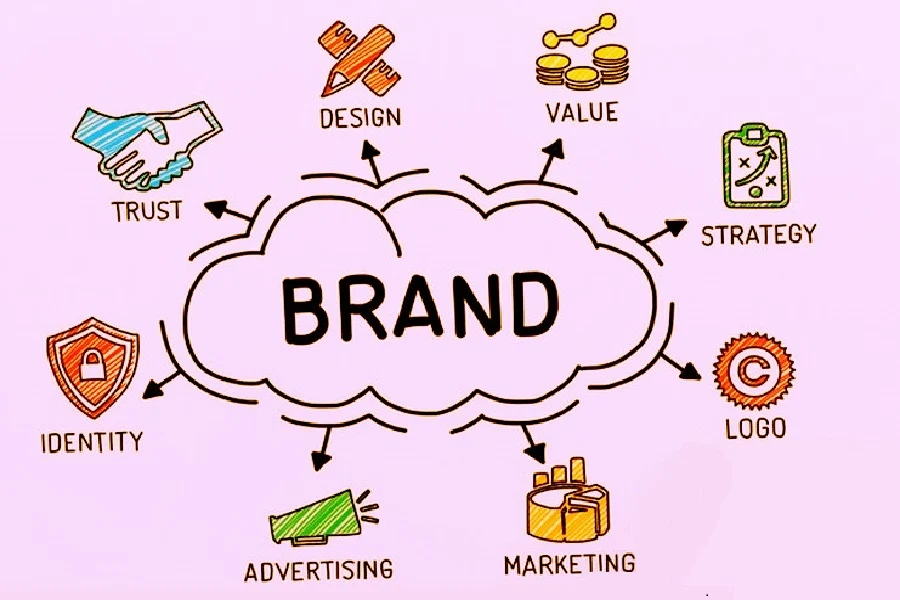If you’re a small business owner trying to connect with potential clients, make sure your marketing plan is based on a strong brand. Tips for building a memorable brand entail developing a unique product or service first, followed by developing an identity and story for your company that accurately represents your offerings.
A well-made product won’t go very far in today’s market. You also need a brand identity to reach the top of the market. A company’s identity is its brand. This extends beyond the company’s real goods and services. Customers are aware of what to anticipate in terms of quality, appearance, functionality, and social relevance when a business has a strong brand identity.
The brand name itself, product lineup, product design (including typography, shapes, and brand color palette), package design, advertising, and the slogan or tagline used in content marketing are all elements of a company’s brand. From the first impression to lifetime involvement, all of these components communicate a brand’s message and voice to the target audience.
Ways To Build A Memorable Brand

1. Define Your Brand Purpose
Your brand purpose is the foundation of your identity and one of the tips for building a memorable brand. It articulates why your business exists beyond making a profit. A clear and compelling purpose resonates with your audience and gives them a reason to connect with your brand.
How To Define Your Brand Purpose:
- Reflect on the core values and mission of your business.
- Identify the unique value you offer to customers.
- Craft a purpose statement that is succinct and inspiring.
For example, Patagonia’s purpose goes beyond selling outdoor gear; it emphasizes environmental sustainability and activism. This clear purpose attracts like-minded customers and strengthens brand loyalty.
2. Understand Your Target Audience
Knowing your audience is crucial to creating a brand that speaks to them and an answer to how to build a memorable brand. Understanding their needs, preferences, and pain points helps you tailor your messaging and offerings.
Steps To Understand Your Audience:
- Conduct market research to gather demographic and psychographic data.
- Create detailed customer personas to visualize your ideal customers.
- Engage with your audience through surveys, social media, and direct interactions.
By deeply understanding your audience, you can develop a brand voice and visual identity that align with their values and aspirations.
3. Develop a Unique Value Proposition (UVP)
A Unique Value Proposition (UVP) defines what sets your brand apart from competitors. It communicates the distinct benefits your brand delivers and why customers should choose you.
Crafting A Strong UVP:
- Identify your brand’s unique strengths.
- Highlight the benefits that matter most to your target audience.
- Keep your UVP clear, concise, and memorable.
For instance, Apple’s UVP revolves around innovation, quality, and seamless user experiences. This strong UVP positions Apple as a leader in technology and design.
4. Create a Consistent Visual Identity
A consistent visual identity ensures that your brand is instantly recognizable. It encompasses elements such as your logo, color palette, typography, and imagery.
Building A Strong Visual Identity:
- Design a logo that reflects your brand’s essence.
- Choose a color palette that evokes the desired emotions.
- Use consistent typography and imagery across all platforms.
Consistency builds trust and reinforces brand recognition. For example, Coca-Cola’s signature red color and timeless logo have contributed to its enduring brand identity.
5. Develop a Distinctive Brand Voice
Your brand voice is how you communicate with your audience, which is one of the tips for building a memorable brand. It should reflect your brand’s personality and resonate with your target audience.
Tips For Crafting A Brand Voice:
- Define your brand’s tone, whether it’s formal, friendly, playful, or authoritative.
- Use language that aligns with your brand’s values and audience preferences.
- Maintain consistency in tone across all communication channels.
Mailchimp, for example, uses a friendly and approachable tone that appeals to its diverse customer base, making its communication engaging and relatable.
6. Leverage Storytelling
Storytelling humanizes your brand and creates emotional connections with your audience. Sharing authentic stories helps your audience relate to your brand and its values.
Effective Storytelling Strategies:
- Share the story of your brand’s origin and mission.
- Highlight customer success stories or testimonials.
- Use storytelling to showcase how your brand solves problems.
Brands like Nike excel at storytelling by celebrating the perseverance and achievements of athletes, inspiring their audience, and reinforcing their brand ethos of “Just Do It.”
7. Build Emotional Connections
Emotional branding taps into the feelings and experiences of your audience, creating a deeper bond. That is a handy answer to how to build a memorable brand.
Ways To Foster Emotional Connections:
- Use visuals and messaging that evoke positive emotions.
- Align your brand with causes that matter to your audience.
- Show genuine care and appreciation for your customers.
Brands like Dove have successfully built emotional connections by promoting body positivity and self-esteem, making their campaigns memorable and impactful.
8. Deliver Consistent and Exceptional Customer Experiences
Your brand is defined by how customers perceive their interactions with you. Consistently delivering exceptional experiences builds trust and loyalty.
Enhancing Customer Experiences:
- Prioritize excellent customer service.
- Ensure consistency across all touchpoints, from your website to social media.
- Actively seek feedback and address customer concerns promptly.
Amazon’s success lies in its commitment to customer-centricity, from fast delivery to responsive support. This consistency reinforces trust and brand loyalty.
Memorable Brands That Have Stood the Test of Time
Memorable brands possess the unique ability to leave a lasting impression on consumers through their innovative approaches, consistency, and emotional resonance by following the tips for building a memorable brand. These brands become cultural icons, shaping industries and inspiring loyalty across generations. Here are a few examples of brands that have stood out as unforgettable.
Apple: Apple is synonymous with innovation and sleek design. Known for products like the iPhone, MacBook, and iPad, Apple’s commitment to quality, user experience, and minimalistic aesthetics has set it apart. Its marketing campaigns, such as the iconic “Think Different” slogan, have further cemented Apple’s status as a visionary leader in technology.
Coca-Cola: Coca-Cola is a masterclass in brand consistency. For over a century, its red-and-white logo and distinct bottle shape have remained instantly recognizable. Coca-Cola’s advertising, such as the timeless “Holidays Are Coming” campaign, has helped the brand evoke feelings of happiness and togetherness, making it a global favorite.
Nike: Nike’s “Just Do It” slogan and swoosh logo have become symbols of athleticism and perseverance. Through compelling storytelling, Nike has connected with audiences emotionally, celebrating the spirit of sports and achievement. Collaborations with athletes and innovative product lines continue to keep the brand relevant and inspiring.
LEGO: LEGO’s colorful building blocks have inspired creativity in children and adults alike for decades. The brand has evolved by incorporating popular culture, producing themed sets around franchises like Star Wars and Harry Potter, and launching movies and video games. This adaptability has ensured LEGO remains a cherished household name.
Disney: Disney is synonymous with magic and storytelling. From its animated classics to theme parks and streaming platforms, Disney has created an immersive brand experience. The iconic castle logo and characters like Mickey Mouse have become enduring symbols of joy and imagination.
FAQ
Q: Which five Cs make up branding?
A: For a personal brand to be successful, clarity, consistency, content, connection, and confidence are all equally crucial components. Your brand can undoubtedly assist you in achieving your objectives if you concentrate on cultivating and mastering each of the five C’s.
Q: What are branding’s four V’s?
A: Vision, values, voice, and visuals are the four V’s. Finding out what your brand is all about and how you plan to convey and present it to the public is one of the goals here.
Q: Which three major branding categories are there?
A: The following are the most popular branding styles to assist you in creating a memorable brand: branding of products. Individual branding and business branding.










